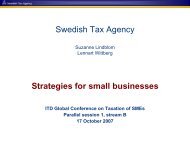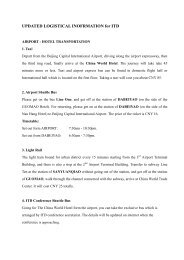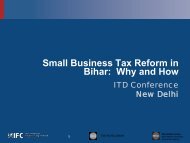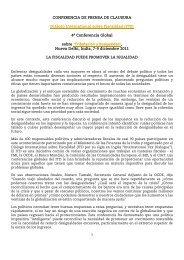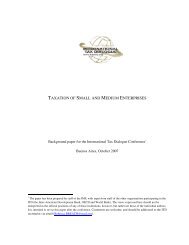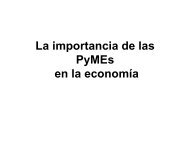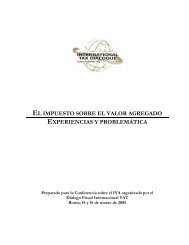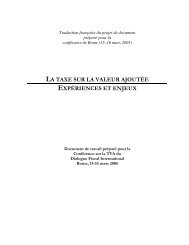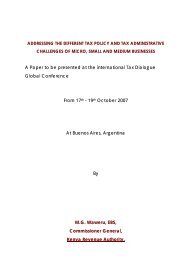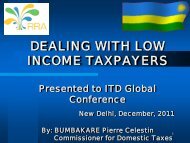Arcotia Hatsidimitris - International Tax Dialogue
Arcotia Hatsidimitris - International Tax Dialogue
Arcotia Hatsidimitris - International Tax Dialogue
You also want an ePaper? Increase the reach of your titles
YUMPU automatically turns print PDFs into web optimized ePapers that Google loves.
34 – 3. GETTING OFF TO A GOOD START<br />
records (2) tax adjustment records (3) records of transactions with associated businesses and (4)<br />
evidence to demonstrate an “arm’s length” result it requires business to be able to provide and when<br />
these records need to come into existence. Similarly, Austria has no specific documentation<br />
requirements but a recent court decision has made it clear that the taxpayer must be in a position to<br />
produce data on which a prudent business manager would have been able to base a pricing decision.<br />
In the experience of many tax administrations the crucial issue is not the quantity of transfer<br />
pricing documentation, including any formal transfer pricing report that is provided, but the quality of<br />
the information it contains and whether the facts support the documentation produced.<br />
<strong>Tax</strong> administrations and business considered that there are advantages and disadvantages to the<br />
two general approaches to business records requirements. Where legislation sets out specific transfer<br />
pricing record requirements this undoubtedly provides some certainty for business, particularly as it<br />
relates to the imposition of penalties for inadequate or incomplete records. On the other hand<br />
legislative requirements are often criticised by business for imposing an undue compliance burden,<br />
particularly where the level of documentation required appears to be out of proportion to the amount<br />
of tax at risk for the controlled transaction under consideration. Some businesses welcome an absence<br />
of statutory requirements and are comfortable relying on the guidance provided, whereas others are<br />
concerned that because of the lack of certainty they err towards overprovision and incur unnecessary<br />
costs. Major advisory firms often need to review transfer pricing policies and the relevant business<br />
records for their clients in the context of certifying financial statements, and in some cases in<br />
connection with due diligence exercises associated with mergers and acquisitions. The level of risk of<br />
subsequent litigation can affect the depth of the review required.<br />
Whilst some advisers and businesses raised the issue of consistency as between different tax<br />
administrations, most were unwilling to achieve consistency at the price of all tax administrations<br />
moving to the approach of the most onerous. Advisers also asked that tax administrations remember<br />
that the document keeping requirement in one tax administration can inform another tax<br />
administration of the documents likely to be available.<br />
Despite these variations in approach the practical experience of tax administrations in dealing<br />
with business records is remarkably similar. Even where there is a statutory framework prescribing<br />
the business records, the quality of the information provided by business can be very variable. The<br />
sheer volume of business records can be an issue as well, making it hard to focus the examination on<br />
the business records that are relevant to the specific issues at the heart of the enquiry. <strong>Tax</strong><br />
administrations felt that whilst this was a result of the inherent fact dependent nature of transfer<br />
pricing, the provision of business records could be used as a delaying tactic by business, or even a way<br />
of deliberately distracting the tax administration from the heart of an audit or enquiry. <strong>Tax</strong> experts in<br />
business too were concerned about the quantity of business records that are maintained to justify the<br />
transfer prices that have been used. They considered that business sees the preparation of voluminous<br />
business records as a way of minimising the risk that tax administrations will seek to make a transfer<br />
pricing adjustment. At the extreme, this can lead to the preparation of certain business records for<br />
their own sake.<br />
There was a broad consensus that in formulating requests for business records tax administrations<br />
should keep at the forefront of their mind the purpose of the audit or enquiry i.e. to test the actual<br />
transactions against the arm’s length standard and to return regularly to this to test the necessity of<br />
obtaining further information. As Annex 3 makes clear, in France the tax administration is careful to<br />
assemble as much information as it can before opening a transfer pricing enquiry and the first step in<br />
the enquiry itself is to meet with the taxpayer and agree what questions need to be addressed and over<br />
what timescale. Whilst in the first instance, the request may have to be fairly wide-ranging in order to<br />
DEALING EFFECTIVELY WITH THE CHALLENGES OF TRANSFER PRICING © OECD 2012



